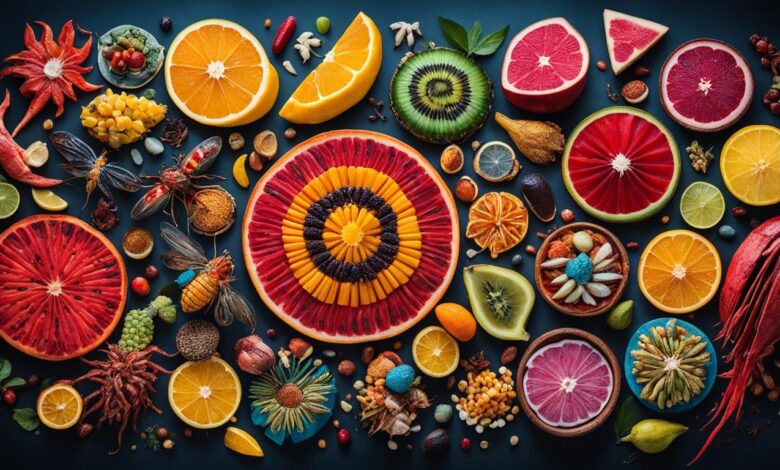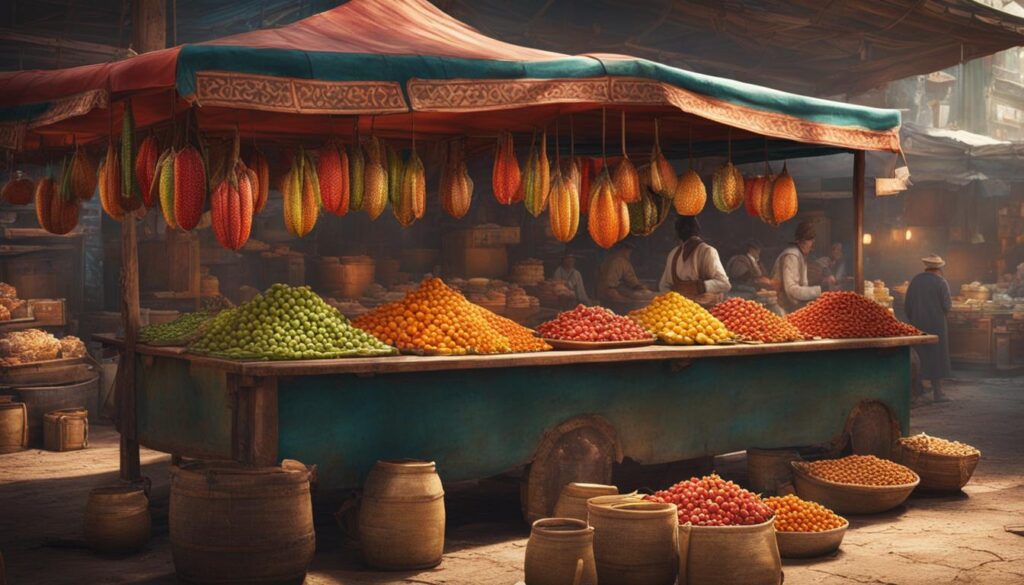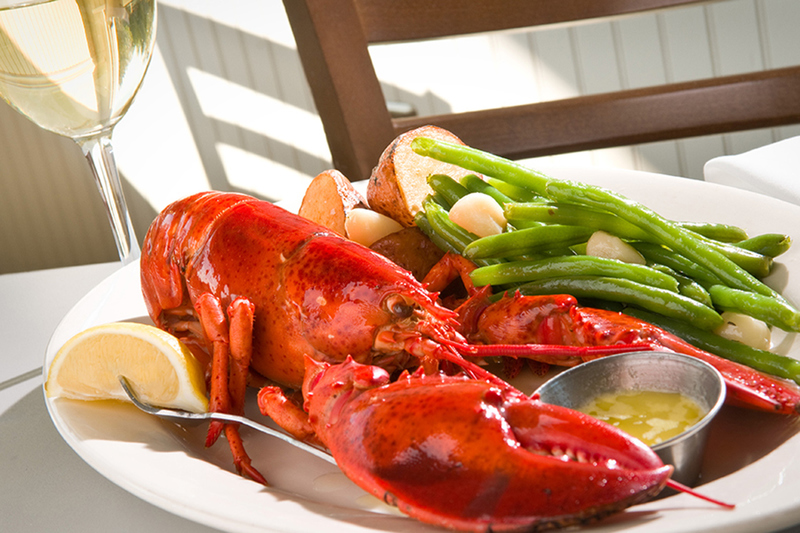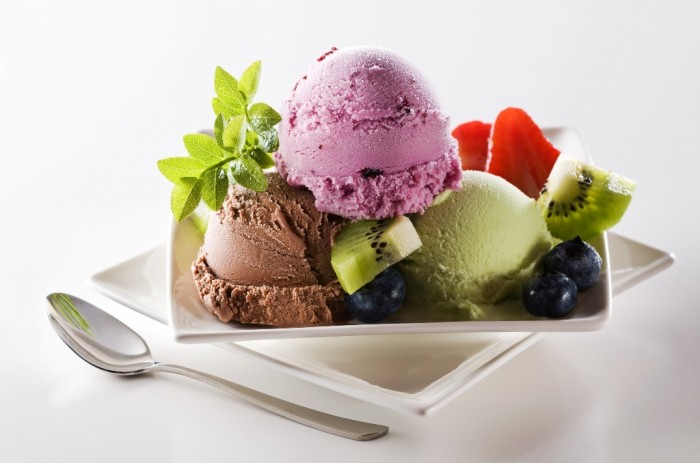
The 35 Strangest Foods Around the World: A Weird Food Gallery
Welcome to a journey into the world of strange and unusual foods! In this article, we will explore the most peculiar and bizarre dishes consumed in different cultures. From insects and arachnids to sea creatures, dairy and eggs, meat and poultry, unusual combinations and preparations, regional specialties with unique ingredients, and even alcoholic beverages with a twist, we will take a culinary adventure that will leave you both amazed and intrigued.
Have you ever wondered what the weirdest food in the world is? Or maybe you are curious about the strangest foods from around the world? Well, you are in for a treat! From fried tarantulas in Cambodia to live octopus in South Korea, the world of strange foods is full of surprises.
So, get ready to delve into the 10 weirdest foods that people eat and need to try! From Japan’s wasp crackers to Thailand’s fried grasshoppers, we will uncover the most bizarre foods that exist. Along the way, you might find yourself both fascinated and slightly grossed out, but that’s all part of the adventure.
So sit back, relax, and let’s dive into the strange and wonderful world of weird food!
What are the Strangest Foods Around the World?
Before we dive into the specific categories of strange foods, let’s take a moment to understand what makes a food strange or weird. Different cultures have their own unique culinary traditions and preferences, and what may seem strange or unusual to one person may be considered a delicacy in another part of the world. From insects and exotic animal parts to fermented foods and unusual combinations, the boundaries of what we consider normal can be stretched when it comes to food.
1. Insects and Arachnids
In many cultures, insects and arachnids are considered a delicacy and a valuable source of protein. From fried grasshoppers in Thailand to deep-fried spiders in Cambodia, the consumption of insects as food has a long history. In Japan, wasp crackers are a popular snack, while stink bugs are enjoyed in various countries in Africa. Mopane worms are a staple in Southern Africa, and locusts are part of traditional diets in Israel. These unusual foods may seem strange to some, but they play an important role in the culinary traditions of these regions.
Exploring the world of edible insects, we encounter a variety of fascinating and unique culinary experiences. In Thailand, jing leed, or grasshoppers, are a popular street food snack. These crispy and savory insects are often seasoned with spices and served as a crunchy delicacy. Meanwhile, in Cambodia, fried spiders are a local delicacy that draws both locals and adventurous tourists. These arachnids are typically seasoned and cooked to perfection, offering a unique and flavorful experience.
The culinary landscape in Japan offers its own take on edible insects with wasp crackers. These light and crispy snacks are made by mixing rice crackers with fermented wasps, creating a crunchy treat that is enjoyed by many. In Africa, stink bugs are harvested and consumed in various countries as a source of protein. These bugs are often dried, roasted, or sautéed with spices to enhance their unique flavors.
Further south in Southern Africa, mopane worms are a traditional delicacy. These worms are the caterpillar stage of the emperor moth and are rich in protein and essential nutrients. Mopane worms are usually dried, fried, or stewed, adding a unique texture and taste to local dishes.
Finally, in Israel, locusts have been part of traditional diets for centuries. Locusts are often boiled, cooked, or roasted, and they provide a valuable source of protein in many communities. While the idea of consuming insects and arachnids may seem strange to some, these foods have long been celebrated as delicious and nutritious culinary options in their respective regions.
2. Sea Creatures
The world’s oceans are home to some of the strangest and most fascinating creatures, and it should come as no surprise that they also provide us with some of the strangest foods. From live octopus in South Korea to the potentially deadly fugu (pufferfish) in Japan, seafood enthusiasts can explore a variety of unique dishes. Sannakji, also known as live octopus, is a popular delicacy in South Korea where diners can experience the sensation of the still-moving tentacles in their mouths.
In Japan, fugu or pufferfish is a highly prized and potentially dangerous delicacy that must be prepared by specially trained chefs to remove the toxic parts of the fish. Bird’s nest soup, made from the nests of swiftlets, is a delicacy in parts of Southeast Asia known for its unique texture and nutritional value.
Tuna eyeballs are commonly enjoyed in Japan and are considered a delicacy with a unique texture and flavor. Fermented herring, known as surstromming, is an acquired taste in Sweden and is known for its pungent aroma. Shark fin soup, a dish made using the fins of sharks, is a controversial delicacy in China due to concerns about the sustainability of shark populations.
Sea cucumber is a prized ingredient in East and Southeast Asian cuisine and is known for its gelatinous texture and ability to absorb the flavors of other ingredients in a dish. These bizarre seafood options showcase the adventurous nature of culinary exploration and offer a different experience for those willing to venture beyond the familiar.
3. Dairy and Eggs
When it comes to dairy products and eggs, there are also some peculiar delicacies to be found around the world. Casu marzu, or maggot cheese, is a specialty from Italy that features live maggots in the cheese. Century eggs, a Chinese delicacy, are preserved eggs that undergo a fermentation process, resulting in a unique texture and flavor. In the Philippines, balut is a fertilized duck egg that is boiled and eaten with salt, chili, and vinegar, including the partially developed embryo inside. These dairy and egg products may be unusual to some, but they offer a glimpse into the diverse culinary traditions and tastes of different cultures.
4. Meat and Poultry
When it comes to unique and unusual meats, the world never fails to surprise. From the fermented shark of Iceland to the guinea pig delicacy in Peru, there’s a wide variety of bizarre meats consumed in different cultures.
Hákarl (Fermented Shark) – Iceland
In Iceland, hákarl is a traditional dish made from fermented shark meat. Although the smell is often described as ammonia-like, it is considered a delicacy and an important part of Icelandic cuisine.
Cuy (Guinea Pig) – Peru
Cuy, or guinea pig, is a popular and traditional dish in Peru. Roasted or fried, this small rodent is enjoyed for its tender meat and unique flavor.
Chicken Feet – Multiple Countries
Chicken feet are not only a popular street food snack in various countries, but they are also used in soups and stews around the world. They are known for their gelatinous texture and rich flavor.
Haggis – Scotland
Haggis is a traditional Scottish dish made from minced sheep’s offal, including the heart, liver, and lungs, mixed with onions, oatmeal, and spices. It is traditionally cooked in a sheep’s stomach.
Rocky Mountain Oysters (Bull Testicles) – United States
Rocky Mountain oysters, also known as bull testicles, are a unique meat dish commonly found in the United States, particularly in the Rocky Mountain region. They are often breaded and deep-fried.
Kangaroo – Australia
Kangaroo meat is a popular and sustainable alternative to traditional meats in Australia. It is known for its lean texture and gamey flavor.
Snake Soup – China
Snake soup is a delicacy in Chinese cuisine, particularly in southern China. It is often made with snake meat, along with a variety of ingredients, herbs, and spices to create a flavorful and nutritious soup.
Bushmeat – Africa
Bushmeat refers to various types of wild game that are consumed in Africa. It includes animals such as antelope, wild boar, and monkey, among others. Bushmeat plays an important role in traditional African cuisine.
Dog – Korea, China, and Vietnam
In certain cultures, particularly in parts of Korea, China, and Vietnam, dog meat is consumed as food. It is often prepared in various ways, including grilled, stewed, or even in traditional hot pots.
Cat – East Asia
While less common and controversial, the consumption of cat meat does occur in some parts of East Asia. It is considered a delicacy by a small portion of the population.
5. Unusual Combinations and Preparations
Sometimes, the strangest foods can come from unusual combinations and preparations. People have discovered unique and surprising ways to create culinary experiences that challenge our taste buds. In this section, we’ll explore some of the most bizarre combinations and preparations that you can find around the world.
Sourtoe Cocktail – Canada
The Sourtoe Cocktail is a peculiar drink that originated in Canada. It involves adding a preserved human toe to a glass of alcohol, such as whiskey or vodka. The toe is typically mummified and garnishes the drink as a unique and unusual touch. While it may sound strange, the Sourtoe Cocktail has become a popular attraction in some Canadian bars and is enjoyed by adventurous drinkers.
Jellied Moose Nose – Canada
In Canada, jellied moose nose is a traditional delicacy. This unusual dish involves boiling moose snouts until they become tender, then removing the skin and cartilage. The nose is then cooked in a broth until it becomes gelatinous, creating a unique texture and flavor. Jellied moose nose is a regional specialty that showcases the creativity and resourcefulness of Canadian cuisine.
Fried Tarantulas – Cambodia
In Cambodia, fried tarantulas are a regional delicacy. These large spiders are seasoned with herbs and spices, then deep-fried until crispy. While it may seem intimidating to some, fried tarantulas are enjoyed by locals and adventurous visitors alike. They are said to have a crunchy texture and a flavor reminiscent of crab or chicken.
Witchetty Grub – Australia
Indigenous Australians have been consuming witchetty grubs for thousands of years. These grub larvae are found in the roots of various native Australian trees. They are typically cooked by roasting or pan-frying and are considered a high-protein food source. Witchetty grubs have a nutty flavor and a chewy texture, making them a unique part of Australian culinary tradition.
Durian (Fruit with a strong odor) – Southeast Asia
Durian is a fruit native to Southeast Asia that is often considered both a culinary delicacy and a controversial food. It is known for its distinctive smell, which some people find unpleasant or even repulsive. However, durian enthusiasts appreciate its rich, creamy flesh, which has been described as a mix of sweet, savory, and slightly alcoholic flavors. It is commonly used in desserts, ice creams, and other sweet treats in the region.
Huitlacoche (Corn Fungus) – Mexico
Huitlacoche, also known as corn fungus, is a culinary specialty in Mexico. It is a type of fungus that infects ears of corn and causes the kernels to swell and turn dark. While some may see it as a blight, others consider huitlacoche a delicacy. It has a earthy, savory flavor that is prized in Mexican cuisine. Huitlacoche is used in a variety of dishes, including quesadillas, soups, and sauces.
Escamoles (Ant Larvae) – Mexico
In Mexico, escamoles are considered a delicacy. These small white ant larvae are harvested from the roots of agave plants. They have a buttery, nutty flavor and a slightly crunchy texture. Escamoles are commonly used in omelettes or served on their own as a filling dish. Despite their unusual origins, they are highly sought after and enjoyed by many.
6. Regional Specialties with Unique Ingredients
Every region has its own unique culinary specialties that may be considered strange or unusual by outsiders. These regional dishes often showcase the creative combinations and use of unconventional ingredients that reflect the local culture and traditions. From cow or sheep stomach dishes in the Middle East, East Europe, and Turkey to deep-fried butter balls in the USA, these regional specialties offer a taste of the unexpected.
Khash (Cow or Sheep Stomach) – Middle East, East Europe, and Turkey
Khash is a traditional dish made from cow or sheep stomach. It is often prepared by boiling the stomach with other spices and ingredients to create a flavorful and hearty dish. Khash is a popular winter dish in many Middle Eastern, East European, and Turkish cuisines, known for its rich taste and unique texture.
Deep Fried Butter Balls – USA
In the United States, deep-fried butter balls are a decadent and indulgent treat. These balls of butter are coated in batter and deep-fried until golden and crispy on the outside, while remaining rich and creamy on the inside. This unique American snack is often enjoyed at fairs and festivals.
Tripe – Worldwide
Tripe refers to the lining of the stomach of various animals, such as cows, sheep, or pigs. While it may seem unusual to some, tripe is consumed in various forms worldwide. It can be found in soups, stews, and even as a filling for tacos in Mexican cuisine. Tripe is known for its unique texture and ability to absorb flavors, making it a versatile ingredient in many cultures.
Black Pudding (Blood Sausage) – Worldwide
Black pudding, also known as blood sausage, is a type of sausage made with animal blood, usually from pigs or cows. It is mixed with a filler, such as fat, oatmeal, or breadcrumbs, and seasoned with spices before being cooked. Black pudding is enjoyed in various forms around the world, including the United Kingdom, Ireland, Spain, and other countries. It is known for its rich, savory flavor and distinctive dark color.
Muktuk (Whale Skin and Blubber) – Greenland
Muktuk is a traditional food in Greenland, consisting of whale skin and blubber. It is often eaten raw or fermented and is a significant part of the Inuit diet. Muktuk is prized for its high-fat content, which provides essential nutrients and energy in the challenging Arctic environment.
Shiokara (Fermented Seafood) – Japan
Shiokara is a fermented seafood dish commonly enjoyed in Japan. It is made by preserving small marine animals, such as squid, fish, or shrimp, in a mixture of salt and enzymes. The fermentation process creates a pungent and intense flavor that is often enjoyed as a condiment or served with rice or noodles. Shiokara is a unique culinary experience for those who appreciate the distinct flavors of fermented seafood.
| Regional Specialty | Unique Ingredient | Origin |
|---|---|---|
| Khash | Cow or Sheep Stomach | Middle East, East Europe, and Turkey |
| Deep Fried Butter Balls | Butter | USA |
| Tripe | Lining of the Stomach | Worldwide |
| Black Pudding (Blood Sausage) | Animal Blood | Worldwide |
| Muktuk | Whale Skin and Blubber | Greenland |
| Shiokara | Fermented Seafood | Japan |
7. Alcoholic Beverages with a Twist
To wrap up our exploration of the strangest foods around the world, we can’t forget about the unique alcoholic beverages that defy convention. These drinks add an extra element of strangeness to the world of food and drink.
Snake Blood Liquor – Vietnam
In Vietnam, one peculiar alcoholic beverage that stands out is snake blood liquor. This unusual drink involves the consumption of snake blood mixed with rice wine. Considered a delicacy and believed to offer health benefits, snake blood liquor is an intriguing choice for those looking to experience a truly unique twist on traditional spirits.
Tequila with Worm – Mexico
When it comes to iconic alcoholic beverages with a twist, Mexico’s tequila with a worm takes the spotlight. This traditional drink features a worm, typically from the agave plant, preserved inside the tequila bottle. While tequila itself is renowned worldwide, the addition of the worm adds an extra layer of intrigue and curiosity, making it a memorable choice for adventurous drinkers.
From snake blood liquor in Vietnam to tequila with a worm in Mexico, these unusual alcoholic beverages push the boundaries of what we consider normal in the world of drinks. Whether you’re seeking a novelty experience or simply want to expand your taste horizons, these bizarre drinks offer a unique twist that is sure to leave a lasting impression.
8. Desserts and Sweets
Do you have a sweet tooth? Do you like to try new and unusual foods? If you answered yes to both of these questions, then you’ll definitely want to check out some of the weirdest desserts and sweets from around the world!
Cheese Tea
This Taiwanese beverage is made by blending tea with cheese – yes, cheese! It might sound strange, but it’s actually quite delicious.
Snake Wine
This Vietnamese “wine” is made by infusing rice wine with the venom of a snake. It’s said to have many health benefits, so if you’re brave enough to try it, go for it!
Beondegi (Silkworm Pupae) – South Korea
If you’re looking for a truly unique and bizarre culinary experience, look no further than South Korea’s beondegi. Beondegi are silkworm pupae that are commonly steamed or boiled, and sometimes served as street food.
While the thought of eating pupae may not be appetizing to everyone, those who have tried beondegi generally say that they have a nutty flavor and a chewy texture. If you can get past the initial “ew” factor, beondegi can be a surprisingly tasty snack.
If you’re still not sure about eating pupae, you can always start with tuna eyeballs. Yes, you read that correctly – tuna eyeballs are also a popular street food in South Korea. While they may look unappetizing, they’re actually quite delicious. Tuna eyeballs are typically boiled or stewed, and are said to have a similar taste and texture to octopus.
So, if you’re feeling adventurous and are looking to try something new, why not give beondegi or tuna eyeballs a try? You may just find that you enjoy them!
Frog Smoothie – Various Countries
Frog smoothies might not sound appetizing to some, but in many cultures around the world, they’re considered a delicious and nutritious treat! If you’re curious about trying this unusual food, here’s what you need to know.
Frogs have been a part of human diets for centuries. In many cultures, they’re considered a delicacy, and their meat is often used in traditional dishes. While frog legs are the most popular way to eat frog, some people also enjoy drinking frog smoothies.
Frog smoothies are made by blending frogs with milk, fruits, and other ingredients. They can be sweet or savory, depending on the ingredients used. Frog smoothies are popular in many countries, including Thailand, Laos, Vietnam, and Cameroon.
If you’re interested in trying a frog smoothie, there are a few things you should know. First, make sure you only consume frog meat that has been properly cooked. Eating raw or undercooked frog meat can lead to illness.
Second, be aware that frog smoothies can have a strong taste. If you’re not used to eating frog meat, the flavor might be overwhelming. Start by blending a small amount of frog meat with other ingredients to get started.
If you’re looking for a new and interesting way to get your daily dose of protein, consider trying a frog smoothie. With a little bit of preparation, you can enjoy this delicious and nutritious treat from various cultures around the world!
Deep-Fried Grasshoppers – Mexico
Do you consider yourself an adventurous eater? If so, you may want to add deep-fried grasshoppers to your list of culinary experiences. While this may sound like a dish that would be found in a remote, rural area of Mexico, you can actually find them in Mexico City – one of the largest, most cosmopolitan cities in the world.
The grasshoppers are usually collected in the wild, although some farmers do raise them specifically for this purpose. They are then cleaned and deep-fried. The end result is a crunchy, salty treat that is said to taste something like popcorn.
If you’re wondering if people actually eat grasshoppers, the answer is yes! They are a popular snack food in many parts of Mexico and are often served with beer. So, if you’re ever in Mexico City and feeling adventurous, be sure to give deep-fried grasshoppers a try.
Conclusion: Exploring the World’s Weird Food Culture
There’s no denying that the world is a weird and wonderful place. And when it comes to food culture, it’s even weirder and more wonderful. From raw horse to typically served insects, there’s a whole world of weird food out there waiting to be explored.
So what exactly is “weird” food? Well, it’s pretty much anything that falls outside of the mainstream. That means anything that isn’t typically served in restaurants or found in supermarkets. It also includes anything that might be considered strange or unusual by the average person.
So why would anyone want to explore the world’s weird food culture? Well, for one, it can be a lot of fun. It’s also a great way to learn about new cultures and broaden your horizons. And of course, it’s always exciting to try something new.
So whether you’re looking for a new culinary adventure or just want to learn more about the world’s many different food cultures, be sure to check out some of the weird and wonderful foods out there. Who knows, you might just find your new favorite dish!
Celebrating Culinary Diversity
When you sit down to a meal, you’re not just nourishing your body, you’re also nourishing your soul. And when you share a meal with others, you’re sharing a part of yourself. So let’s celebrate the beautiful diversity of food and culture that exists in the world.
There are so many different cuisines to explore, each with their own unique flavors and ingredients. For example, Chinese cuisine includes dishes like century egg and stew, while Indian cuisine features picks like curry and tandoori chicken.
No matter where you come from, there’s a whole world of culinary diversity out there to explore. So let’s celebrate it!
Respecting Traditional Cuisine
Today, there are a lot of modern chefs who are taking traditional dishes and giving them a twist. While this can be great, it’s important to remember the roots of these dishes. Traditional cuisine is often based on using local ingredients and seasonal produce. This is something that should be respected.
Grasshoppers are a traditional dish in many parts of the world. In Mexico, they’re often served with a lime and chili powder. In Thailand, they’re often served as a snack. And in China, they’re considered a delicacy. While grasshoppers may not be to everyone’s taste, it’s important to respect the tradition of eating them.
Traditional cuisine is an important part of the animal culture and heritage. It’s a way of connecting with the past and celebrating the present. So next time you’re trying a new dish, remember to respect the tradition it comes from.














